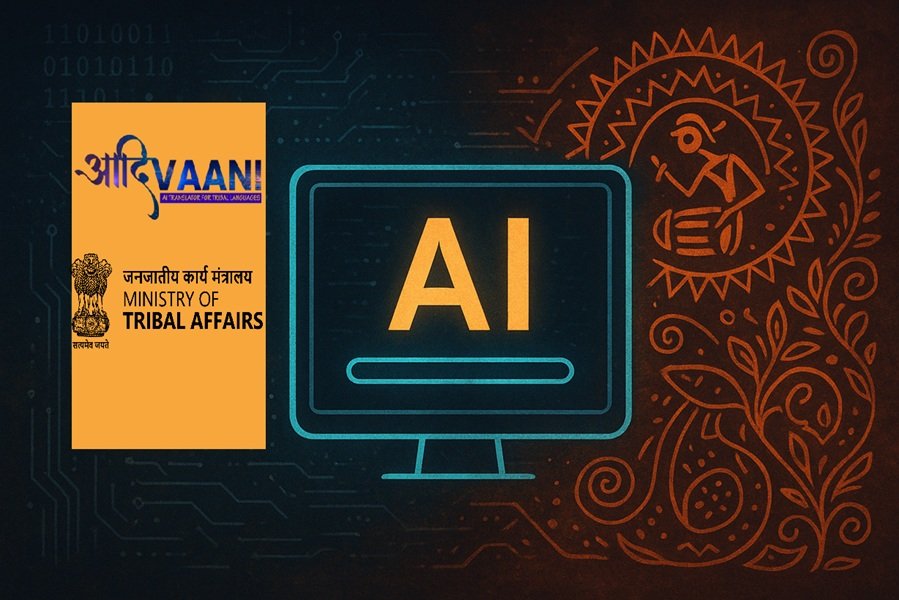
Introduction
India’s tribal heritage is not only cultural but linguistic — over 400 tribal languages are spoken across the country. Yet, many of these languages are at risk of extinction due to lack of documentation, modernization, and shrinking intergenerational transmission. To safeguard this invaluable linguistic diversity, the Ministry of Tribal Affairs, Government of India, has launched Aadi Vaani (aadivaani.tribal.gov.in) — an AI-powered multilingual translation platform designed to preserve, promote, and digitize tribal languages.
This visionary initiative combines artificial intelligence, natural language processing, and cultural research to empower Adivasi communities and bridge communication barriers between tribal and mainstream societies.
What Is Aadi Vaani?
Aadi Vaani is an official government platform that enables translation between tribal languages and major Indian languages such as Hindi and English. It uses advanced machine translation and speech recognition technology to convert spoken or written tribal languages into readable formats — and vice versa.
Launched in 2025 under the guidance of the Ministry of Tribal Affairs, Aadi Vaani marks a major milestone in India’s digital inclusion journey. It is not just a translator; it’s a cultural preservation tool, a communication bridge, and a digital learning resource all in one.
Why Aadi Vaani Matters
Language is more than words — it’s identity, memory, and heritage. India’s tribal languages carry centuries of wisdom, folklore, and oral traditions. However:
- Many tribal languages have limited written records
- Dialects vary across states and regions
- Government schemes and health messages often fail to reach people in their native tongue
Aadi Vaani directly addresses these challenges by bringing AI technology to the grassroots. It helps tribal communities access education, healthcare, and governance in their own languages while preserving their linguistic heritage for future generations.
Supported Languages in the Beta Version
At present, Aadi Vaani supports four tribal languages in its Beta Phase:
- Santali (Odisha & Jharkhand)
- Bhili (Madhya Pradesh & Gujarat)
- Mundari (Jharkhand)
- Gondi (Chhattisgarh & Telangana)
Languages like Kui, Garo, and others are currently under development and will be integrated in the next update. The long-term vision is to include all 461 tribal languages recognized across India.
Key Features of Aadi Vaani
Aadi Vaani is built as a comprehensive multilingual AI system with the following features:
1. Text-to-Text Translation
Users can type words or sentences in tribal languages and instantly translate them into Hindi or English, and vice versa. This helps improve communication between government officials, teachers, and local communities.
2. Speech-to-Text and Speech Translation
Users can speak directly into the microphone, and Aadi Vaani transcribes and translates the speech in real time. This feature is especially valuable in regions with low literacy rates.
3. Text-to-Speech Functionality
The platform can speak translations aloud, making it accessible to non-literate users and elders in tribal villages.
4. OCR and Document Digitization
Aadi Vaani includes Optical Character Recognition (OCR) to digitize old manuscripts, folk tales, and cultural documents — converting physical text into searchable, machine-readable formats.
5. Entertainment and Cultural Section
The platform also offers an “Entertainment” section, showcasing movies, songs, and folklore in tribal languages. This promotes learning through art and keeps oral traditions alive.
6. User Registration and Mobile App
Users can register through the official website or Android app. The mobile version ensures that people in remote areas can access translation tools on smartphones.
Technology Behind Aadi Vaani
Aadi Vaani’s AI system is developed through collaboration with top Indian institutions, including:
- IIT Delhi
- BITS Pilani
- IIIT Hyderabad
- IIIT Naya Raipur
- Tribal Research Institutes (TRIs) from Jharkhand, Odisha, Madhya Pradesh, and Meghalaya
These institutions contributed data, linguistic research, and machine learning models to make translations possible for low-resource tribal languages.
The platform uses Neural Machine Translation (NMT) models similar to IndicTrans2 and No Language Left Behind (NLLB) frameworks. Since tribal languages lack large digital datasets, Aadi Vaani relies heavily on community-sourced audio, oral data, and bilingual glossaries to train its AI engines.
Role in Education and Public Welfare
Aadi Vaani has the potential to revolutionize education and governance in tribal regions. For example:
- Teachers can translate textbooks into local tribal languages for better comprehension.
- Health workers can deliver crucial information about vaccination or disease prevention in native languages.
- Government officials can communicate directly with tribal citizens during public outreach programs.
In addition, the translation of PM speeches, public schemes, and awareness videos into tribal languages can dramatically improve civic participation and policy reach.
Cultural Preservation and Heritage Digitization
Many tribal languages are transmitted orally and lack standardized scripts. Aadi Vaani acts as a digital archive for these endangered languages. By recording, translating, and storing oral literature, the project ensures that folk stories, songs, and proverbs are preserved for future generations.
This also creates a living digital museum of India’s Adivasi linguistic heritage — one that can be studied by scholars, educators, and future generations alike.
Challenges Ahead
Despite its promise, Aadi Vaani faces some important challenges:
- Data Scarcity: Many tribal languages lack written material for training AI models.
- Dialect Diversity: The same language may have multiple dialects across states.
- Internet Access: Remote tribal areas often face connectivity issues.
- Community Engagement: Success depends on participation from native speakers.
- Ethical Data Use: Respect for cultural privacy and consent is crucial.
The government aims to address these through community partnerships and continued AI improvement.
Future Roadmap
The long-term roadmap for Aadi Vaani includes:
- Adding 50+ more tribal languages
- Offline functionality for rural regions
- Integration with Digital India and e-Governance services
- Collaboration with educational boards for tribal language learning
- Open APIs for developers and NGOs
- Expansion into health, agriculture, and local administration apps
If implemented effectively, Aadi Vaani could become the world’s largest tribal language preservation project.
Significance for India’s Tribal Communities
The Aadi Vaani initiative is more than just a technological achievement — it’s a symbol of empowerment. It gives Adivasi communities their voice in the digital age, ensuring they are not left behind in India’s rapid technological progress.
By valuing indigenous languages, the government acknowledges that tribal knowledge systems and identities are integral to India’s cultural unity and diversity.
Conclusion
Aadi Vaani embodies the spirit of “Digital Inclusion for All.” It merges AI innovation with cultural preservation, ensuring that India’s tribal languages — once on the verge of extinction — now have a place in the country’s digital future.
With strong community participation and sustained government support, Aadi Vaani could become a global model for using artificial intelligence to protect linguistic diversity and empower indigenous communities.






